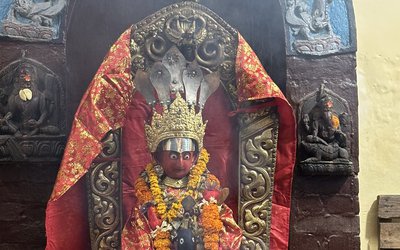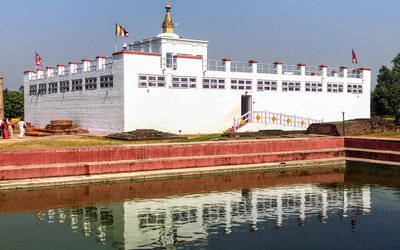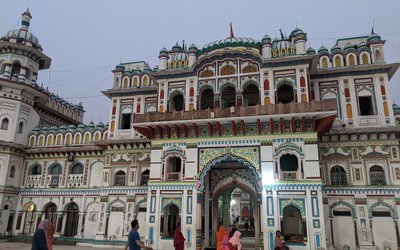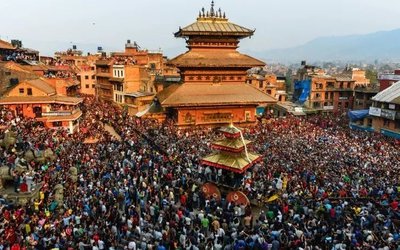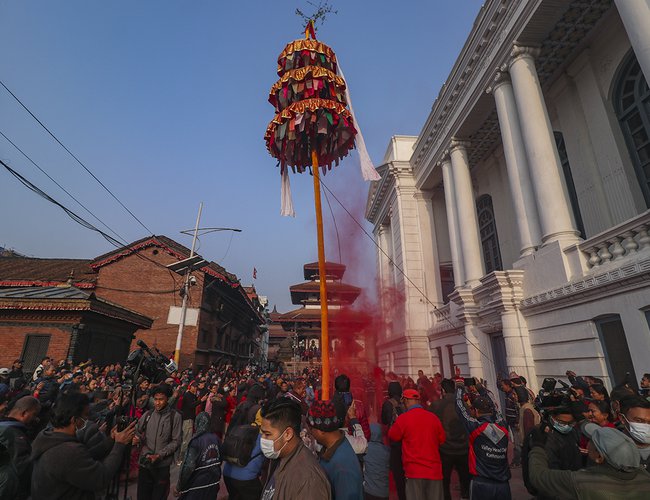
The Fagu Purnima or Holi Festival (or festival of colors) is a fascinating cultural and religious celebration that encompasses much more than just throwing colored dye in the air.
Holi is being observed in hilly areas, including the federal capital in Nepal today.
The festival, also called spring festival, marks the arrival of spring and the harvest season. The festival will be observed on Monday across Terai districts in the country.
The first day of the festival is called Holika Dahan and the second day Dhuleti or Holi. Holika Dahan, the death of Holika, the symbol of triumph of good over evil, is marked by lighting a bonfire, and performing a special Puja to burn evil spirits.
In Kathamndu Valley, people will burn the Chir erected in Basantpur after mid-night as a symbol of killing Holika.
Among various cultural festivals celebrated in Nepal, the Fagu Purnima bears its own specialty and significance. People from old to young enjoy the festival with enthusiasm. One of the widely observed festivals of the country, the festival begins on the eighth day of the new moon and ends with the burning of the 'Chir'.
What Is Holi Celebrated for?
Holi is a Hindu festival that has been celebrated since ancient times. The Holi Festival is celebrated as a way to welcome in spring, and also is seen as a new beginning where people can release all their inhibitions and start fresh. It is said that during the Holi Festival, the gods turn a blind eye, and it’s one of the few times extremely devout Hindus allow themselves to let loose.
They open up and enjoy each other’s company, take time to dance and party, and throw their cultural norms to the side. On the first day of the festival, a bonfire is lit to symbolically burn away all the bad and give way to a colorful and vibrant new future.
At the Holi Festival, participants throw powder dye into the air, covering all in attendance with vibrant colors. In a religious sense, the colors are rich with symbolism and have multiple meanings: they can mean a vibrant new life and even represent sin in a way. For some, washing off the dye at the end of the day can mean new commitment to live well, as cleansing oneself of evils and demons.
Which Religion Celebrates Holi Festival?
The Holi Festival is primarily celebrated by Hindus. That said, the festival is a very inclusive, as one of the main themes of the festival is unity. So, while the Holi Festival is rooted in Hindu tradition, it is a celebration that happens all over the world. It brings people together and invites them to throw away their inhibitions, feeling united in one big colorful group.
What Is the Story of Holi Festival?
It’s said that the Holi Festival was originally a ceremony for married women to spread prosperity and goodwill on their new family. Since then, the festival has evolved to encompass much more. Now, one of the main focuses of the Holi Festival is a celebration of the victory of good over evil.
Good overcoming evil in Hinduism is rooted in the story of Hiranyakashipu. He was an ancient king who claimed to be immortal and demanded to be worshipped as a god. His son Prahlad was deeply devoted to worshipping the Hindu deity Vishnu, and Hiranyakashipu was angry that his son worshipped this god over him. According to the story, the Lord Vishnu appeared as half-lion and half-man, and killed Hiranyakashipu. In that way, good conquered evil.
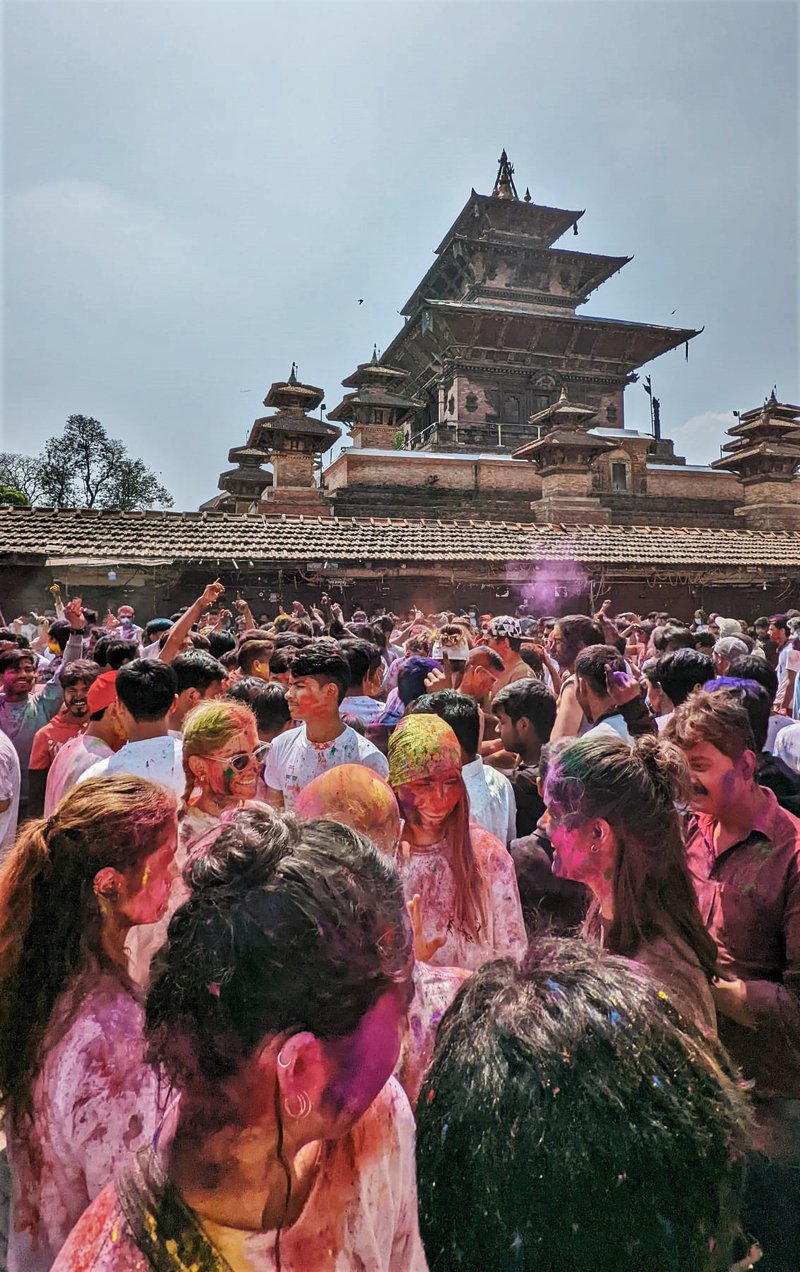
Another story tied to the Holi Festival is that of Radha and Krishna. As the eighth incarnation of the Hindu god Vishna, Krishna is seen by many as the supreme god. Krishna is said to have blue skin because as legend has it, he drank poisonous milk from a demon when he was a baby. Krishna fell in love with the goddess Radha, but feared she would not love him because of his blue skin – but Radha allowed Krishna to dye her skin with color, making them a true couple. On Holi, Festival participants apply color to each other’s skin in honor of Krishna and Radha.
Where Is Holi Festival Mainly Celebrated?
Holi Festival is mainly celebrated in Nepal and India, but over the years it has grown to be a celebration that takes place in many communities all across the globe. The festival is most widely and openly celebrated in cities like Delhi, Agra, and Jaipur, and while each city may celebrate slightly differently, you can expect to see plenty of colors, music, and dance.
Why Do We Celebrate Holi in America?
There are many Hindu populations in the United States, particularly in larger metropolitan areas. In addition to the religious meaning of the festival, some have adopted it in the United States for the spectacle and entertainment. Holi Festivals can be found in Boston, New York, Houston, and even Spanish Fork, Utah.
When Is Holi Festival?
Holi Festival is celebrated on the last full moon day of the lunar month of (Phalguna), which is generally around the end of March. The exact date of Holi may vary from year to year.
What Is the Holi Festival Like?
The Holi Festival is wild: think big crowds, colored dye, water guns, music, dancing, and partying. During the Holi Festival, people dance through the streets and throw colored dye on each other. The Holi Festival is a happy time when people come together as one and let go of their inhibitions.
What Are Some Ways to Experience the Holi Festival?
If you live in the United States, you may be able to find a large city that hosts a Holi Festival, or Festival of Colors. For the full experience though, you need to attend a Holi Festival celebration in India – and a great way to experience Holi in India is to volunteer there; check out Helen’s recap of volunteering in India and experiencing the Holi Festival firsthand. Whether or not you’re there for the actual festival, you’ll gain a deeper understanding of Indian culture and Hinduism, and become enveloped in the country’s rich heritage.
What are the biggest takeaways?
Nepal and India is an amazingly religious and culturally rich country to visit. From the Holi Festival to the people to the animals, there are so many experiences to be had and connections to be made. Take some time to learn about India and its rich traditions and plan your volunteer trip today. If you’re lucky, you may even have an authentic Holi Festival experience!
- Global IME Capital’s “Samunnat Yojana 2” Mutual Fund Opens for Public Offering from July 6
- Jul 03, 2025
- Nepal Among Investment-Friendly Countries, Immense Opportunities Exist – Prime Minister
- Jul 03, 2025
- Supreme Court upholds appointment of 52 officials
- Jul 03, 2025
- Weather Forecast: Generally Cloudy In The Hilly Areas With Heavy Rainfall In Some Areas Of Bagmati And Koshi Province
- Jul 03, 2025
- MCA-Nepal Welcomes Continued U.S. Support for MCC Nepal Compact Implementation
- Jul 02, 2025


